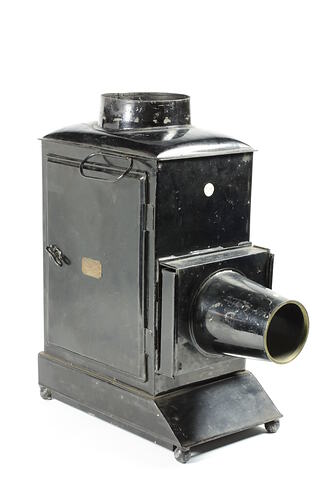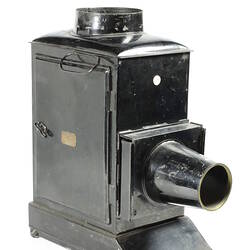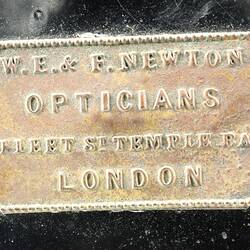Summary
Black enamelled metal magic lantern body which would have been used to view lantern slides.
The company which manufactured this particular lantern was operational under the name W.E. & F. Newton between 1852-57, and as Newton & Co. from 1858. By the 1880s it had become one of Britain's most important manufacturers of magic lanterns and slides. They continued in business into the 1940s. Circa 1913 the company moved from their longstanding address in Fleet Street, London to establishments in King and Wigmore Streets.
While the invention of the magic lantern is generally seen to be in the 17th century, its greatest popularity as an optical projector spans the late 18th century to the early decades of the 20th century. It was used both as a means of entertainment and education.
This lantern projector is part of the Francis Collection of pre-cinematic apparatus and ephemera, acquired by the Australian and Victorian Governments in 1975. David Francis was the curator of the National Film and Sound Archive of the British Film Institute as well as being a co-founder of the Museum of the Moving Image in London, which was operational between 1988 and 1999.
Physical Description
Black enamelled rectangular metal body. Missing all inner components. Four ball feet at each corner. Hinged side door with swivel latch. Brass name plate on side door. Drawn wire handles top front of each lateral side. Large circular aperture in roof for chimney. Missing back door of illumination chamber.
More Information
-
Collection Names
-
Collecting Areas
-
Acquisition Information
Loan & Subsequent Donation from Australian Film Institute (AFI), Mr David Francis, by Nov 1990
-
Collector
Mr David Francis, London, Middlesex, England, Great Britain, 1990
-
Manufacturer
W.E. & F. Newton, 3 Fleet Street, London, England, Great Britain, 1852-1857
-
Inscriptions
On circular paper sticker on top of lens tube: '46' On circular paper sticker on front of body: '54' On attached brass plaque on side door: 'W.E. & F. NEWTON/OPTICIANS/3 FLEET ST TEMPLE BAR/LONDON'
-
Classification
-
Category
-
Discipline
-
Type of item
-
Overall Dimensions
340 mm (Length), 150 mm (Width), 380 mm (Height)
-
References
Early Photography, Company Details, Newton [Link 1] Accessed 28 Nov. 2011
-
Keywords
Lantern Projectors, Magic Lanterns, Pre-Cinema Moving Images, Projectors



